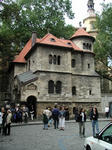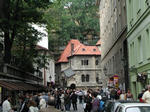
The Jewish Museum in Prague is located on the site of what was once the Prague Jewish ghetto. It houses a collection of approximately
40,000 artistic artifacts and 100,000 items of printed material.
Synagogue objects, mainly textiles and silver, comprise almost two-thirds of the collection. The rest of the collection consists of household ritual items, paintings, drawings, prints, manuscripts and photographs, as well as artifacts from the Terezin concentration camp (which includes
unique collection of children's drawings).
The Jewish Museum was established in 1906 in order to preserve precious ritual objects from some of the Prague synagogues that had been demolished during the clearing of the ghetto at the turn of century. The majority of the Museum's collection, however, was accumulated during the Nazi occupation from 1942-44. As the Nazis systematically liquidated the Jewish Communities of Bohemia and Moravia, the confiscated property from these communities was sent to Prague for storage, cataloging and exhibition.

Soon after the end of the war, the Museum was taken over by the Communist government. It wasn't until 1994 that the Museum was returned to the Federation of Jewish Communities in the Czech Republic.
The Jewish Museum is made up of a number of historical sites in the area of the Jewish town, including the Old Jewish Cemetery, the Pinkas Synagogue, the Ceremonial Hall, the Klaus Synagogue, the Maisel Synagogue and the Spanish Synagogue.
The Klaus and Maisel Synagogues, as well as the Ceremonial Hall were adapted to feature exhibits of items from the Museum's collection. The Pinkas synagogue was converted into
a Holocaust memorial to Jewish victims from Bohemia and Moravia and now houses an exhibit of children's drawings from Terezin.
 Guide
Guide 


